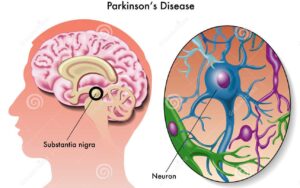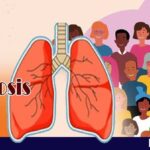Parkinson’s Disease (PD) primarily affects the movements of the body, making the person slow in all the activities. World Parkinson’s Day is observed on April 11 every year. Despite many years of research and understanding, treatment for Parkinson’s disease remains challenging.


Parkinson’s disease (PD) is the second most common degenerative disease that affects the brain, causing significant disability. The incidence of PD varies from 8.6 to 19 per 1 lakh population. Every year, 50,000 new people are diagnosed with the disease. Parkinson’s disease primarily affects the movements of the body, making the person slow in all the activities, and is associated with shaking of the body called tremors.
CAUSES
The exact cause of the Parkinson’s disease is not clearly understood. However, there are several propositions:
1. Environmental – Exposure and consumption of pesticides, environmental endotoxins and heavy metals have been incriminated.
2. Genetic – Several gene abnormalities which influence synuclein protein metabolism have been identified for contributing to an entity called Hereditary or Familial Parkinson’s Disease. The prominent genes are Parkin gene and Alphasynuclein gene.
3. Idiopathic – A majority belong to this category where the exact cause is not known. It is also known as primary PD.
4. Secondary PD – Tumours, vascular infarcts, drugs, and metabolic diseases can produce Parkinsonism. Based on this, the disease is classified as follows:
- Primary or Idiopathic.
- Secondary or Acquired.
- Hereditary or Familial.
- Parkinson Plus syndromes.
SYMPTOMS
The cardinal symptoms of Parkinson’s disease are: 1. Shaking of hand or leg (tremor) at rest. 2. Slowness of movement (Bradykinesia). 3. Stiffness of limbs and body (rigidity). 4. Stooping posture with imbalance (postural instability).
1.TREMOR: Most common symptom. It can be on one side or both sides, affecting the hand, leg or both. Shaking of the hand with pill-rolling movements of the thumb at rest is the classic symptom.
2. BRADYKINESIA: Parkinson’s disease dominantly affects the motor movements of the body. Hence there is slowness of movement along with difficulty in the whole course of movement process, planning, initiation and execution. This will make the person slow in all the activities. The face becomes expressionless.
3. RIGIDITY: Stiffness of muscle tone affecting the smoothness of all the movements and activities. It may be associated with joint pains, leg pains and back pain. In the advanced stages, it can be severe with total cessation of movement, making the person wheelchair bound and disabled.
4. POSTURAL INSTABILITY: As the disease progresses, they develop impaired balance with frequent falls, sustaining several injuries and fractures. The other recognized motor movements include a rapid shuffling gait with a forward belt posture called festination, speech and swallowing difficulties; the handwriting becomes very small and irregular.
NON-MOTOR SYMPTOMS:
Involvement of various parts of the brain can lead to a variety of non-motor symptoms which are equally disabling. Cortical involvement causes Dementia, Cognitive Impairment and at times Frank Psychosis. Basal ganglia damage leads to apathy, restlessness and impulse control disorders. Brainstem involvement leads to depression, anxiety and sleep disorders. Peripheral nervous system problems can cause Orthostatic Hypotension, constipation, pain and sensory disturbances. They can also have hallucinations, constipation, drooling of saliva, speech and swallowing difficulties.
Also read: Dementia – lifestyle changes can lower the risk
DIAGNOSIS
Parkinson’s disease is usually diagnosed by clinical history and examination. There is no specific lab test to establish the diagnosis. However, CT Scan , MRI Scan, SPECT (Single photon emission spectrography) and PET (Positron Emission Tomography) will help in identifying the underlying diseases and also to some extent identify Parkinson Plus Syndromes.
PD PLUS SYNDROMES: These are a variety of progressive degenerative disorders that affect the brain and mimic the main Parkinson’s disease. However, it is important to differentiate since the treatment and the outcomes are completely different. These disorders, unlike PD, progress very rapidly, making the individual disabled in a very short time.
TREATMENTS
All the current available treatments are focused on relieving the symptoms, delay disease progression, preserve and improve functional capacity. The options available are:
1. MEDICAL THERAPY: Levodopa (supplementation of Dopamine) is the mainstay of the medical treatment. This drug is taken orally in multiple doses and relieves all the major symptoms of PD. As the disease progresses, the patients develop drug tolerance, leading to incremental increase in the dosage, often resulting in side effects. When the side effects appear or efficiency of the drug comes down, surgical treatment needs to be considered. This drug acts by directly replacing the dopamine levels in the brain.
The other drugs are to enhance the dopamine production and also to produce symptomatic relief, and also used in combination. They include dopamine agonists, Mao Inhibitors, Anti-cholinergic drugs and Amantidine. All the other non-motor symptoms will be treated symptomatically as and when required. APOMORPHINE is the drug that is recently introduced in Indian market. This is the only drug in injectable form. It can be used whenever a person cannot take oral medications or before surgery.
2. SURGICAL THERAPY: Since Dopamine replacement has its own clinical uncertainties and side effects beyond a particular stage of the disease, surgical treatment is considered to improve the quality of life. Surgical therapy includes:
a. Stereotactic lesioning
b. Deep Brain Stimulation (DBS)
c. Stereotactic Radiosurgery (SRS)
3. MOLECULAR THERAPY: This includes:
a. Cell therapy
b. Gene therapy
c. Monoclonal antibodies
d. Immunotherapy
REHABILITATION
Last but not the least, all these patients require constant rehabilitation to improve their life skills. Several of such treatments will be tailor-made to suit the individual requirements. They include physical therapy, speech therapy, gait therapy, dexterity therapy and cognitive therapy. Despite many years of research and understanding, treatment for Parkinson’s disease remains challenging. All the available therapies today are not curative. So the enigma continues along with the search for newer options. The caregivers also need to understand the problems and the dynamics of the illness. The challenges for the future are early detection, establishing a screening test, predicting the disease, progression and outcome and to create a research model for the future.


Dr. NK Venkataramana
Founder Chairman & Director Neurosciences
Brains Hospital, Bengaluru











